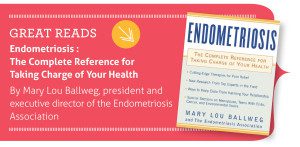Giving birth, multitasking, and asking for directions with boldness and confidence are talents and joys reserved for women and women alone. But with the good can come the uncomfortable, otherwise known as endometriosis.
According to the Endometriosis Foundation of America, the condition impacts more than 8.5 million women in North America and is one of the top three causes of female infertility. While there is no cure for this common condition, many treatments may provide effective relief. With the right doctor and the right therapy, endometriosis can be managed.
By Katie Mena
Full PDF here.
What is endometriosis?
The tissue lining a woman’s uterus is called the endometrium. During monthly menstruation, the body sheds the endometrium and passes it in the form of bloody fluid through the vagina.
Endometriosis occurs when the body does not pass this tissue lining completely through the vagina, but instead retains much of it in organs and structures where it does not belong. “Essentially, what happens in endometriosis is that the cells that line the inner cavity of the uterus (endometrium) grow outside the uterus,” explains Dr. Jeanie Dassow, an OB-GYN with UT Erlanger Women’s Health Specialists. Dr. Dassow says endometriosis is usually found around the ovaries, behind the uterus or even on the bowel and bladder. Once the tissue cells implant in other areas of the body, adhesions, scars and invasive nodules can develop.


OB-GYN, UT Erlanger Women’s Health Specialists
What causes endometriosis?
The cause of endometriosis is still unknown, though there are many theories. The Cleveland Clinic lists the following as possible causes:
Retrograde menstrual flow – When some of the endometrium sheds into the pelvis rather than through the body, the result may be endometriosis.
Genetics – Endometriosis may be inherited or the result of genetic errors.
Hormones – An abundance of estrogen—a hormone involved in the female reproductive cycle—can encourage the development of endometriosis.
Compromised immune system – Autoimmune disorders such as thyroid disease may be associated with endometriosis.
Environmental agents – Researchers are looking into whether exposure to certain man-made chemicals may cause endometriosis.
Who is at risk?
Endometriosis may impact any girl or woman who is menstruating. From the first period until menopause, there is a risk of developing endometriosis. The condition can even persist after menopause.
The Cleveland Clinic reports that between 2-10% of women who are of reproductive age may experience endometriosis.
Do I have endometriosis?
According to the Endometriosis Foundation of America, endometriosis can cause a wide variety of symptoms, including painful periods, heavy periods, infertility, and pain associated with sex or going to the bathroom.
“The most common symptoms are pelvic pain, pain with sex, and infertility,” says Dr. Dassow. “The pelvic pain often includes severe menstrual cramps and pain with having a bowel movement. Some women seek medical attention because the monthly period pain or pain with intercourse interferes with their lives. Others seek medical care because they are having trouble getting pregnant.”
It is important to be aware that any of the following signs listed by the Cleveland Clinic may mean you have endometriosis:
- painful, debilitating menstrual cramps
- ongoing pain in the pelvis
- discomfort during or after sexual intercourse
- pain in the intestine
- uncomfortable bowel movements or painful urination during menstruation
- unusually heavy periods
- spotting and bleeding between periods
- infertility
- fatigue
If you have experienced any of these symptoms, you know how they can impact your daily life. Chronic pain and fatigue can interfere with your work, your overall physical health, and even your personal relationships with family, friends and coworkers. The good news is you can take control.
Take the first step: Talk to your doctor
If you are experiencing any of the symptoms of endometriosis, it is important to talk with a doctor, specifically an obstetrician/gynecologist (OB-GYN) as soon as possible. “Before your visit, record all of your symptoms,” says Dr. James Nunally, an OB-GYN with Premier Health Care of Women’s Health Services. “Your gynecologist will review your symptoms and medical history before performing a routine physical and a pelvic exam.” He or she will be able to conduct a variety of tests to pinpoint the cause of your symptoms. If there is, in fact, a diagnosis of endometriosis, your OB-GYN can outline a strategy to combat the disease. According to the U.S. Department of Health and Human Services, the following tests are most effective when screening for endometriosis:
Pelvic exam – During this test, your doctor applies pressure to the pelvic area to identify large cysts or scars.
Ultrasound – Using a wand-shaped scanner, your doctor can conduct an ultrasound of the vaginal and pelvic areas. The ultrasound images will help identify any cysts that may not be found through a pelvic exam.
Laparoscopy – This surgical procedure is the most accurate way to identify endometriosis. During a laparoscopy, your doctor will use an instrument called a laparoscope to inspect the reproductive organs for endometriosis. During this procedure, sample tissue may be extracted for study and diagnosis.


OB-GYN, Premier Health Care of Women’s Health Services
Treatment is an option
While there is no known cure for endometriosis, several types of treatment can alleviate pain and combat infertility. “If you are diagnosed with endometriosis, there are forms of surgery that can relieve your pain or medical management may be considered to treat it,” says Dr. Nunally. “Some treatments may affect your ability to have more children, so be prepared to discuss your family plan with your OB-GYN.”
Your doctor can help you determine which option best suits you, dependent on your symptoms, age and plans to get pregnant.
Treatment options include:
Pain medication – Over-the-counter medicine such as ibuprofen or naproxen may be all you need to treat mild endometrial pain. If these medicines prove ineffective, your doctor may prescribe a stronger pain reliever.
Hormone therapy – Moderate endometrial pain may be effectively treated through hormone treatment. However, hormones are only recommended for women who do not want to conceive.
Hormone therapy may be administered through pills, shots and even nasal sprays. Birth control pills are the most common form of hormone therapy. These oral contraceptives may be prescribed to manage your menstrual cycle and prevent overgrowth of endometrial tissue. If you do wish to become pregnant, you can simply stop taking the pills. Just keep in mind that the absence of the birth control hormones may cause your endometriosis to return. Other hormone therapies include progesterone, danocrine, and gonadotropin-releasing hormone (GnRH) agonists. These therapies may cause side effects such as weight gain and fatigue. So be sure to talk with your doctor about what to expect if you choose this type of treatment.
Surgery – Severe endometriosis is often treated most effectively with surgery. Some of the options your doctor may recommend include:
º Laparoscopy – During this minimal procedure, doctors will remove unhealthy tissue that may be causing abdominal pain. The goal of this type of surgery is to preserve healthy tissue and offer a quicker recovery.
º Laparotomy – Involving a larger incision than a laparoscopy, a laparotomy allows the doctor to remove large sections of endometriosis in the abdomen or pelvis. The recovery from a laparotomy will take a little longer than the recovery from a laparoscopy.
º Hysterectomy – This surgery involves the removal of the entire uterus and sometimes the ovaries. Women who have had a hysterectomy are not able to get pregnant following the surgery, so this option should be carefully considered and only performed as a last resort.
Remember, you’re not alone
Millions of women and girls around the world suffer from endometriosis every day. The Endometriosis Foundation of America reports that 176 million women worldwide are dealing with the disease currently. The physical and emotional pain caused by endometriosis is very real to many, many women. And researchers won’t give up until there’s a cure.
In the meantime, take full advantage of the treatments that are available and clearly communicate your needs to your doctor, family and friends. Seek out online and community support groups where you can talk with other women living with endometriosis, and read as much as you can about the disease. You are the only person who knows what it feels like to live in your skin. Being present to your endometriosis and the factors that make it better or worse will help you and your doctor find the best treatment.



